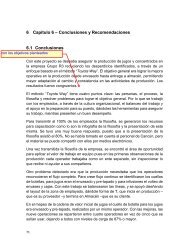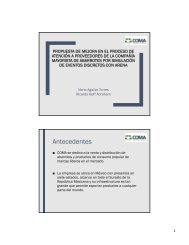Getting Started
You also want an ePaper? Increase the reach of your titles
YUMPU automatically turns print PDFs into web optimized ePapers that Google loves.
A • STATISTICAL DISTRIBUTIONS<br />
The cumulative distribution function F(x) is piecewise linear with “corners” defined<br />
by F(x j ) = c j for j = 1, 2, . . ., n. Thus, for j > 2, the returned value will be in the<br />
interval (x j–1 , x j ] with probability c j – c j–1 ; given that it is in this interval, it will be<br />
distributed uniformly over it.<br />
You must take care to specify c 1 and x 1 to get the effect you want at the left edge of the<br />
distribution. The CONTINUOUS function will return (exactly) the value x 1 with<br />
probability c 1 . Thus, if you specify c 1 > 0, this actually results in a mixed discretecontinuous<br />
distribution returning (exactly) x 1 with probability c 1 , and with probability<br />
1 – c 1 a continuous random variate on (x 1 , x n ] as described above. The graph of F(x)<br />
above depicts a situation where c 1 > 0. On the other hand, if you specify c 1 = 0, you<br />
will get a (truly) continuous distribution on [x 1 , x n ] as described above, with no “mass”<br />
of probability at x 1 ; in this case, the graph of F(x) would be continuous, with no jump<br />
at x 1 .<br />
As an example use of the CONTINUOUS function, suppose you have collected a set<br />
of data x 1 , x 2 , . . ., x n (assumed to be sorted into increasing order) on service times, for<br />
example. Rather than using a fitted theoretical distribution from the Input Analyzer,<br />
you want to generate service times in the simulation “directly” from the data,<br />
consistent with how they’re spread out and bunched up, and between the minimum x 1<br />
and the maximum x n you observed. Assuming that you don’t want a “mass” of<br />
probability sitting directly on x 1 , you’d specify c 1 = 0 and then c j = (j – 1)/(n – 1) for j<br />
= 2, 3, . . ., n.<br />
Range [x 1 , x n ]<br />
Applications<br />
The continuous empirical distribution is often used to incorporate actual data for<br />
continuous random variables directly into the model. This distribution can be used as<br />
an alternative to a theoretical distribution that has been fitted to the data, such as in<br />
data that have a multimodal profile or where there are significant outliers.<br />
155






